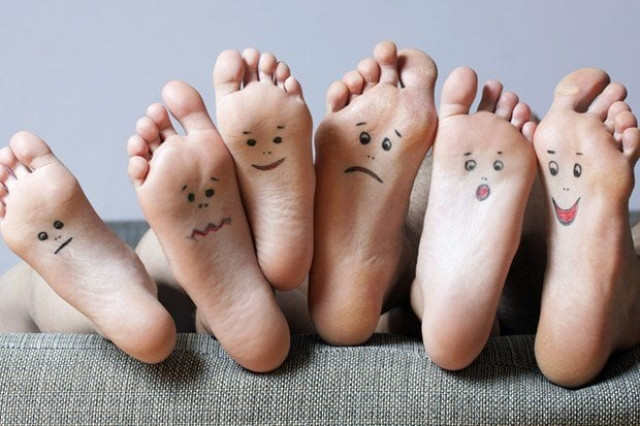7 things your feet say about your health
Hairless feet and toes may mean there is a circulation problem

1. Hairless feet and toes
What it may mean: Circulation problem It may be a pain for the ladies but having hair on your toes is, in fact, a good thing. Sudden baldness of the toes can be a sign that your feet aren’t getting adequate blood supply to sustain hair growth. So, if you find your feet without hair, don’t be too happy and visit a doctor. You might have to check for a pulse in your feet, which is another indication that your heart may not be pumping enough blood to your feet, says Dr Carolyn McAloon, president of the California Podiatric Medication Association, which means you might have a serious cardiovascular issue.
2. Frequent foot cramping
What it may mean: Dehydration and nutritional deficiencies. Randomly occurring cramps are about as general as foot problems. They can be as serious as circulation and nerve issues, or as harmless as a nutritional deficiency. If you work-out regularly, be sure to drink plenty of water, since dehydration often leads to muscle cramping. You might also try upping your intake of potassium, magnesium and calcium, since their deficiencies make cramps occur more frequently. “For relief, soak feet in a warm foot bath and stretch your toes toward your nose, not pointing down,” says Dr McAloon. If the cramps don’t ease up, see your doctor to rule out circulation issues or nerve damage.
3. A sore that won’t heal
What it may mean: Diabetes or skin cancer
Stubborn sores on the feet that don’t go away are red flags for diabetes. Uncontrolled glucose levels in the blood can lead to nerve damage all the way down in your foot, which means, any cut, wound or scrape can come and go without you ever feeling it. And if it gets infected, the most serious cases may call for amputation. A non-healing wound can also be a sign of skin cancer, Dr McAloon says. Melanoma can pop up anywhere on your body, even in between your toes, so be sure to include your feet in your regular skin-check.
4. Perpetually cold feet
What it may mean: Hypothyroidism If you’re about to get married, there’s no need to pay a visit to the doctor for cold feet, but if you always find your feet literally cold, it may be a cause for concern. Hypothyroidism is the most common cause of feet that just can’t get warm. And if you’re over 40, you could be living with a sluggish thyroid without even knowing it. Unfortunately, cold feet are the least of your problems, since hypothyroidism in later stages can also cause hair loss, fatigue, unexplained weight gain and depression. But the good news is that cold feet are the earliest sign of the condition. Get your feet feeling toasty again by heading to your doc for a simple blood test and you’ll start warming up soon after the daily intake of prescribed medication.
5. Numbness
What it may mean: Peripheral neuropathy or a pinched nerve. Numbness is never a good sign in any part of the body and numbness in both the feet is known as peripheral neuropathy, caused most commonly by diabetes or as a side-effect of strong chemotherapy. If you’re experiencing neuroma or numbness in only one foot, it could be due to a pinched nerve in the foot, ankle or back. That’s most likely caused by years of wearing tight shoes. Yes, we are most likely referring to stiletto devotees.
6. Bunions
What it may mean: Inherited faulty foot structure If you thought your bunions and corns were caused exclusively by a closet full of stunning yet painful shoes, you can stop blaming your shoe addiction. Bunions are actually a sign of a flawed foot structure, which is often inherited and aggravated by inappropriate shoes. “The first foot bone drives toward the middle of the body, and you see the bump,” explains Dr McAloon. If you have corns on the underside of your big toe, schedule an appointment for a pedicure and get it scaled and foot-filed to relieve discomfort, at least, temporarily. It can be painful and unsightly, but the only way to really rectify the problem is surgery.
7. Heel pain
What it may mean: Plantar fasciitis You can’t mistake that specific ache — sharp pain in the bottom of the heel when you get out of bed or stand up from a chair. It’s a strain of the ligament that supports the foot arch. And whether you did it by wearing tight shoes, walking in flip-flops all the time, or wearing worn-out workout sneakers, the longer you let it go, the longer it takes to heal and the pain only gets worse. Podiatrists suggest you ease up on your workout at first, and take more rest days to let the arch heel. Also, rethink your footwear, and adopt a good stretching post-workout routine.
Published in The Express Tribune, April 14th, 2015.
Like Life & Style on Facebook, follow @ETLifeandStyle on Twitter for the latest in fashion, gossip and entertainment.



















COMMENTS
Comments are moderated and generally will be posted if they are on-topic and not abusive.
For more information, please see our Comments FAQ